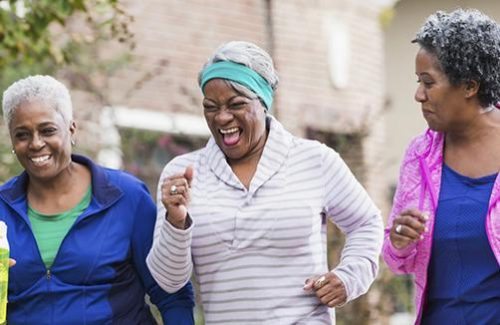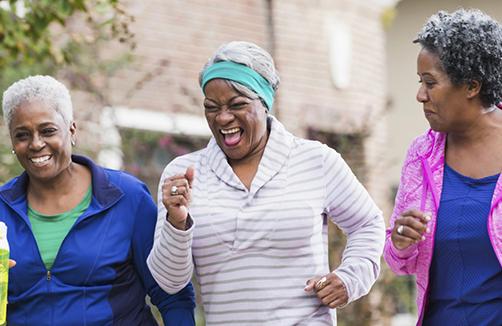Do you know the Eight Factors of Active for Life?
 Adulthood and aging come with their own unique challenges.
Adulthood and aging come with their own unique challenges.
No matter how active you’ve been in the past, it still requires diligence to ensure you’re creating the healthiest lifestyle possible for yourself. In Sport for Life’s resource Durable by Design we’ve broken down the elements of a healthy lifestyle into eight factors, each of them critical to having a well-rounded adulthood.
How many of these do you have covered?
#1. Appropriate Physical Activity
When it comes to physical activity, one size doesn’t fit all. That’s why it’s important to find exercise that’s appropriate for your stage in life.
“The sports and activities individuals do in one stage of life may not be appropriate in the next stage without modification,” reads Durable by Design.
“It is important to combat age-related physical declines through targeted exercises, including balance and strength training. Individuals whom maintain a moderate to high daily level of activity are less likely to be taking multiple medications, seriously injure themselves from an accident, or develop dementia.”
#2. Cognitive Function
Your brain is a crucial part of staying active, and keeping it healthy requires a wide-ranging approach to ensuring you have a balanced lifestyle. Sleep, diet and lifestyle all contribute to your mental agility.
“Similar to the effect sedentary behaviour has on the muscles, organs and bones, a lack of cognitive stimulation deprives the brain of the exercise it needs to maintain optimal function,” reads Durable by Design.
“Performing mental exercises, such as playing sudoku or learning a new hobby, strengthens neuronal connections within the brain, providing participants with a cognitive reserve. Building a cognitive reserve helps to mitigate losses due to injury, illness, and time.”
#3. Psychological Well-being
Adults aiming to have an active life should be cognizant of the role mental health plays.
“Psychological well-being is dependent on a host of factors such as genetics, life experiences, social supports, personality traits, economic conditions, and dealing with the burden of disease or illness,” reads Durable by Design.
“However, there is also strong evidence showing that physical activity produces significant positive effects on basic psychological components such as confidence, self-esteem, social connectedness, and fundamental happiness.”
#4. Social Connection
Being isolated and lonely doesn’t mix well with being healthy. That’s why ensuring that you have positive relationships in your life is key.
“When planning sport or physical activity programs for adults, it is important to consider how to develop the social component. This facet is sometimes overlooked, but even when unplanned it often occurs organically within the group, reads Durable by Design.
“The social aspect of group oriented programs and “beer leagues” will lead to higher retention and increased adherence to the program.”
#5. Embracing Life Transitions
Once you’ve reached adulthood, chances are you’ve already gone through a number of life transitions. Taking the lessons from those experiences and embracing new transitions will have an impact on your lifestyle.
“Many of the transitions that typically occur in later adulthood, such as making the transition from working to partial or full retirement, becoming a grandparent, or even recovering from an injury, illness, or a medical procedure can serve as motivators to maintain or develop a regular exercise routine,” reads Durable by Design.
“For example, the transition to retirement can serve as an opportunity to restructure one’s time and allow for reengagement in sport or the development of a new physical activity.”
#6. Managing Chronic Conditions
Chronic conditions can be a major impediment to healthy living, but it’s possible to manage these conditions and thrive regardless.
“To live well with chronic conditions, it is important to engage in regular exercise. Pain can be a major barrier for many individuals with chronic conditions and though medications may be essential for treatment and for pain control, they can also interfere with balance and sometimes make regular exercise more challenging,” reads Durable by Design.
“However, regular exercise among individuals with chronic health conditions has proven to be an effective way to reduce the number medications an individual takes, to enhance energy, and improve quality of life.”
#7. Mindful Nutrition
It is so important to be aware of what you’re putting in your body.
“Many chronic health conditions, such as high blood pressure, heart disease and diabetes are directly linked to obesity rates. Canada is presently battling an obesity epidemic at all age groups,” reads Durable by Design.
“Fortunately, obesity can be managed through changes in diet and physical activity. It is important to eat plenty of dark green and coloured vegetables, high fibre foods such as apples, beans and lentils, and foods providing monounsaturated fats such as avocados, olive oil, and nuts.”
#8. Durability by Design
At the end of the day, our bodies are meant to be durable.
“The human body is dynamic; by design everyone can be more durable and endure the challenges that aging involves,” reads Durable by Design.
“Engaging in regular exercise is one of the best things individuals can do to ensure that they age successfully. Community sport and recreation programs and opportunities should be adapted to the changing needs of participants across their lifespan.”
*
None of this is easy, but diligence produces results. Keeping these eight factors in mind will help you establish a well-rounded, active lifestyle while neglecting any one aspect can have negative repercussions. To ensure the best outcomes Sport for Life recommends making sure you remain committed to each and every aspect of the Active for Life plan.
It just might change your life.

